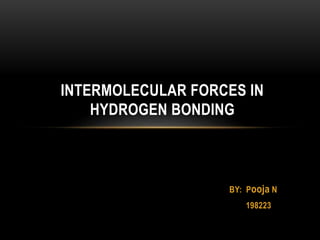
Intermolecular Forces in Hydrogen Bonding - Pooja N
- 1. BY: Pooja N 198223 INTERMOLECULAR FORCES IN HYDROGEN BONDING
- 2. • Ionic bond • Covalent bond • Metallic bond INTRAMOLECULAR FORCES
- 3. Intermolecular forces are forces of attraction and repulsion between molecules that hold molecules, ions, and atoms together. Attractive intermolecular forces are known as VANDER WALLS FORCES. (1) LONDEN FORCES (2) DIPOLE –DIPOLE INTERACTIONS (3) DIPOLE –INDUCED DIPOLE INERACTION Strong type of Dipole-Dipole interaction is called as HYDROGEN BONDING They determine physical properties of molecule like boiling point, melting point, density, enthalpies of fusion. INTERMOLECULAR FORCES
- 4. LONDON FORCES: They are weakest intermolecular forces. Force of attraction between two temporary dipole is known as LONDON FORCES DIPOLE –DIPOLE INTERACTION: Present between the molecules possessing permanent dipole. Partial negative portion of one molecule is attracted to the partial positive portion of second polar molecule. DIPOLE INDUCED DIPOLE INTERACTION: Attractive forces found between the polar molecules having permanent dipole and the molecules lacking permanent dipole. Covalent bonds > Hydrogen bonds > Dipole-Dipole interactions > London dispersion force (400kcal) (12-16 kcal) (0.5-2 kcal) (<1 kcal) STRENGTH OF FORCES
- 5. HYDROGEN BONDING • This is a special kind of dipole-dipole interaction that occurs between a hydrogen atom bonded to either an oxygen , nitrogen or fluorine atom (electronegative atom). • Partial positive end of hydrogen is attracted to partial negative end of oxygen, nitrogen or fluorine of another molecule. • It is relatively stronger forces of attraction between molecules and considerable energy is required to break hydrogen bonds.
- 6. CONDITIONS FOR HYDROGEN BONDING A hydrogen bond H –Z is only effective when Z is strongly electronegative. Higher is the electronegativity greater is the polarisation of the molecule. The size of electronegative atoms should be small. Smaller is the size greater is the electrostatic attraction. Thus only F,O and N atoms satisfy these conditions and form hydrogen bond of higher electronegativities. Chlorine having same electronegativity as that of nitrogen does not form hydrogen bond due to its large size.
- 7. TYPES OF HYDROGEN BONDING Intermolecular hydrogen bonding Intramolecular hydrogen bonding INTERMOLECULAR HYDROGEN BONDING When hydrogen bonds formed between the two or more molecules of the same or different compounds they are called intermolecular hydrogen bonds. Hydrogen fluoride, water, alcohols, and solutions of alcohol or ammonia in water involve intermolecular hydrogen bonding.
- 8. EXAMPLES OF INTERMOLECULAR HYDROGEN BONDING: (1) WATER Water molecules contains a highly electronegative oxygen atom linked to hydrogen atoms. Due to large electronegativity difference the oxygen end of the molecule becomes negative, where as the H-atom becomes positive. The negative end of one molecule attracts the positive end of the other and hydrogen bonding takes place.
- 9. (2) HYDROGEN FLUORIDE Fluorine , having the highest value of electronegativity, forms the strongest hydrogen bonds. Orientations of various atoms and bond lengths
- 10. (3) AMMONIA It contains highly electronegative atom N linked to H-atoms. (4) ALCOHOLS AND CARBOXYLIC ACIDS
- 11. INTRAMOLECULAR HYDROGEN BONDING These involve electrostatic force of attraction between hydrogen and an electronegative element both present in the same molecule.
- 12. EFFECT OF HYDROGEN BONDING ON PHYSICAL PROPERTIES OF COMPOUNDS (1) Ethyl alcohol (C2H5OH) is liquid at room temperature and its boiling point is high (780C) while dimethyl ether (CH3OCH3) is a gas its boiling point is 23.60C. Ethyl alcohol molecules are associated through intermolecular hydrogen bond. So molecules become closer to each other therefor ethyl alcohol is liquid at room temperature & more energy is required to break these forces. So its boiling point Is more. While in Diethyl ether hydrogen bond is not present
- 13. (2) Alcohols are more soluble in water. Alcohols and water molecules are associated through intermolecuar hydrogen bonding. (3) The boiling point of monocarboxylic acid is higher than expected. Monocarboxylic acid molecules are associated through intermolecular hydrogen bonding. So more amount of energy is required to break these bonds
- 14. (4) Glucose, urea, sugar, alcohol ,glycerol etc. are covalent compound but they are soluble in water. • They form intermolecular hydrogen bond with water molecules. (5) Hydrogen chloride ( HCl ) is a gas at room temperature while Hydrogen fluoride (HF ) is liquid. • HF molecules are associated through inter molecular hydrogen bond and it exists as (HF)n. So molecules of HF come closer to each other . Hence HF is liquid.
- 15. (6) p-nitrophenol is more soluble than o-nitrophenol in water p-nitrophenol forms intermolecular hydrogen bond with water and dissolve in it. While in the case of o-nitrophenol groups are involved in intramolecular hydrogen bond and are not free to form hydrogen bond with water.
- 16. (7) Melting point of p-nitrophenol is more (i.e 114 0C) than o-nitrophenol (i.e 450C). p-nitrophenol molecules are associated through intermolecular hydrogen bond so more amount of energy is required to break these force hence melting point of p-nitrophenol is more. In o-nitro phenol, groups are involved in intramolecular hydrogen bond . So less amount of energy is required to break these forces .Hence melting point of o- nitrophenol is less.
- 17. (8) Ice floats on water. Ice is solid even then it is lighter than water because in ice, water molecules are associated through hydrogen bond . In Ice, water molecules are tetrahedrally arranged, Ice has an open cage like structure . In ice open space is present. Due to open space volume of ice increases and density decreases, so ice floats on water. IMPORTANCE OF HYDROGEN BONDING: Without hydrogen bonding water would exist as gas like hydrogen sulphide. Hydrogen bonding is present in all living organisms. It is present in tissues, organs, blood, bones in animal life. It pleays important role in determining structure of proteins. Stickiness of glue and honey is also due to hydrogen bonding.
- 18. REFERENCES Principles of inorganic chemistry by Puri and Sharma. Organic chemistry by R L Madan
